It’s a Cascade of 14nm CPUs: AnandTech’s Intel Core i9-10980XE Review
by Dr. Ian Cutress on November 25, 2019 9:00 AM ESTCPU Performance: Encoding Tests
With the rise of streaming, vlogs, and video content as a whole, encoding and transcoding tests are becoming ever more important. Not only are more home users and gamers needing to convert video files into something more manageable, for streaming or archival purposes, but the servers that manage the output also manage around data and log files with compression and decompression. Our encoding tasks are focused around these important scenarios, with input from the community for the best implementation of real-world testing.
All of our benchmark results can also be found in our benchmark engine, Bench.
Handbrake 1.1.0: Streaming and Archival Video Transcoding
A popular open source tool, Handbrake is the anything-to-anything video conversion software that a number of people use as a reference point. The danger is always on version numbers and optimization, for example the latest versions of the software can take advantage of AVX-512 and OpenCL to accelerate certain types of transcoding and algorithms. The version we use here is a pure CPU play, with common transcoding variations.
We have split Handbrake up into several tests, using a Logitech C920 1080p60 native webcam recording (essentially a streamer recording), and convert them into two types of streaming formats and one for archival. The output settings used are:
- 720p60 at 6000 kbps constant bit rate, fast setting, high profile
- 1080p60 at 3500 kbps constant bit rate, faster setting, main profile
- 1080p60 HEVC at 3500 kbps variable bit rate, fast setting, main profile
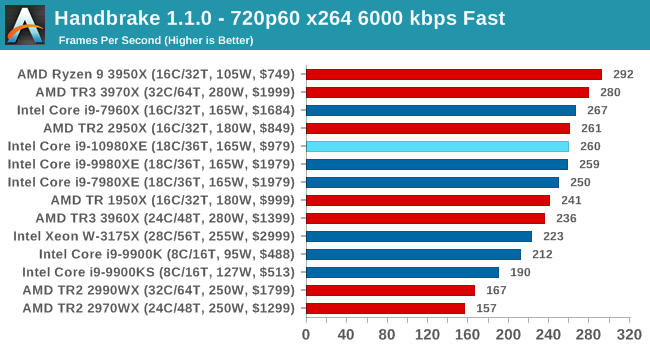
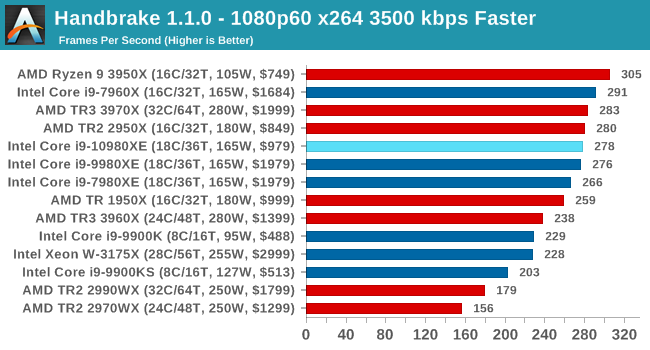
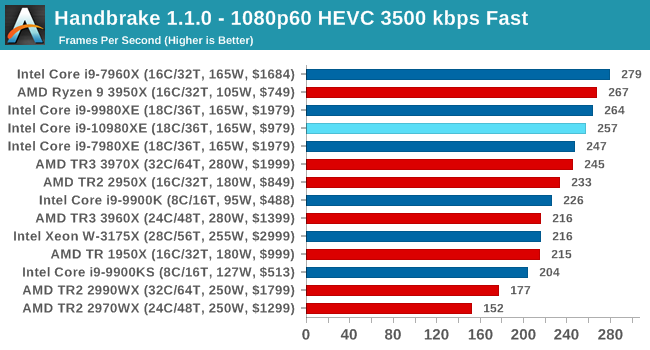
7-zip v1805: Popular Open-Source Encoding Engine
Out of our compression/decompression tool tests, 7-zip is the most requested and comes with a built-in benchmark. For our test suite, we’ve pulled the latest version of the software and we run the benchmark from the command line, reporting the compression, decompression, and a combined score.
It is noted in this benchmark that the latest multi-die processors have very bi-modal performance between compression and decompression, performing well in one and badly in the other. There are also discussions around how the Windows Scheduler is implementing every thread. As we get more results, it will be interesting to see how this plays out.
Please note, if you plan to share out the Compression graph, please include the Decompression one. Otherwise you’re only presenting half a picture.
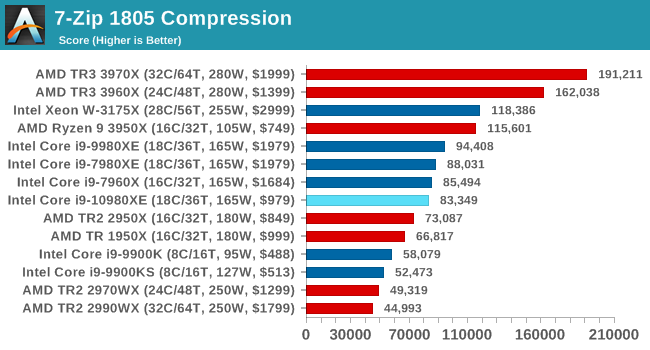
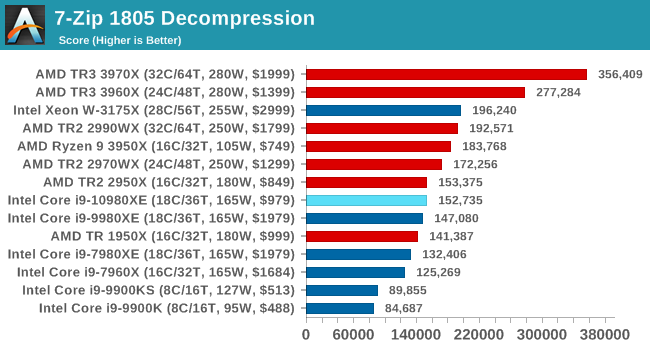
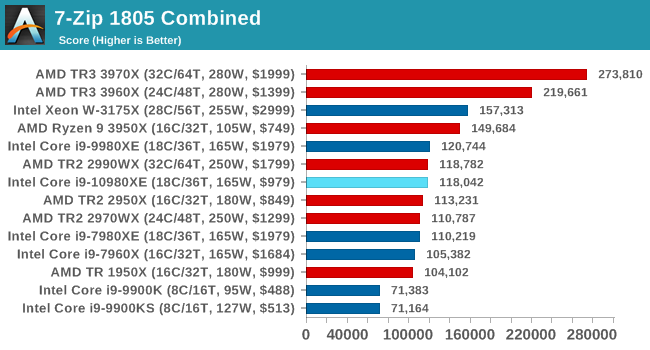
WinRAR 5.60b3: Archiving Tool
My compression tool of choice is often WinRAR, having been one of the first tools a number of my generation used over two decades ago. The interface has not changed much, although the integration with Windows right click commands is always a plus. It has no in-built test, so we run a compression over a set directory containing over thirty 60-second video files and 2000 small web-based files at a normal compression rate.
WinRAR is variable threaded but also susceptible to caching, so in our test we run it 10 times and take the average of the last five, leaving the test purely for raw CPU compute performance.
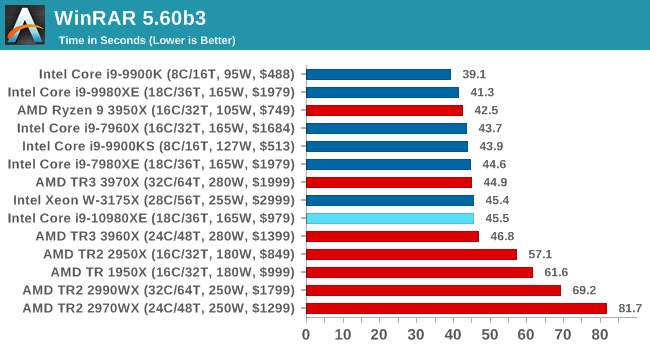
AES Encryption: File Security
A number of platforms, particularly mobile devices, are now offering encryption by default with file systems in order to protect the contents. Windows based devices have these options as well, often applied by BitLocker or third-party software. In our AES encryption test, we used the discontinued TrueCrypt for its built-in benchmark, which tests several encryption algorithms directly in memory.
The data we take for this test is the combined AES encrypt/decrypt performance, measured in gigabytes per second. The software does use AES commands for processors that offer hardware selection, however not AVX-512.
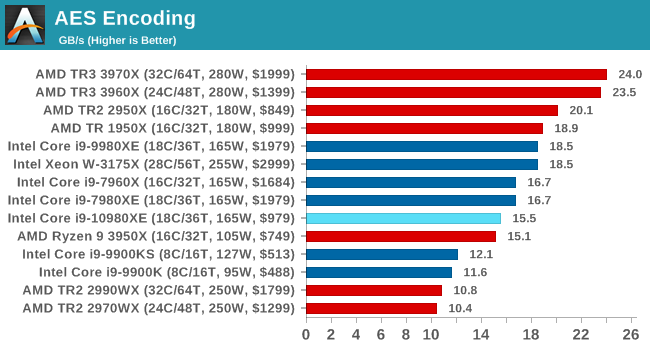
More than a slight regression here in our AES testing - this is probably the most severe of all our tests for how the security fixes have affected performance.










79 Comments
View All Comments
milkywayer - Monday, November 25, 2019 - link
Thank you AMD for strong arming the serial-milker Intel. Price cut from $1900 to $900. Hard to believe Intel would cut down on the core count milking. Am I dreaming?regsEx - Monday, November 25, 2019 - link
Mind it was Intel and without any competition who lowered mainstream price from $500 to $300 back in 2011. 3700X would cost $500 now if not that. So thank you, Intel.Spunjji - Monday, November 25, 2019 - link
Balderdash. Near the end of 2010 you could get a 6-core AMD Phenom II CPU for $270. By 2011, an "8 core" 4-module Bulldozer cost the same and Intel's products were priced to compete with that.So, uh, thanks again AMD..?
karmapop - Monday, November 25, 2019 - link
Sorry, but you may want to dig back into the review archives for some untinted perspective on that info. In fact, you're both incorrect. That mainstream performance pricing shift happened in 2008, with the introduction of the Yorkfield Core 2 Quad chips, and more importantly the Bloomfield Core i7 (with the i7-920 becoming that $300 darling entry point for the enthusiast platform).Those mid-2010 Thuban Phenom II X6 chips? Passably competitive with the lowest end quad-core Bloomfield chips (which were already on the market for a year and a half prior). And let's just forget about the dumpster fire that was Bulldozer, given that fabled FX-8150 had trouble matching the old Thuban Phenom II X6 at launch.
nt300 - Tuesday, November 26, 2019 - link
The FX 8350 & FX 8320 Piledriver CPUs saved AMDs bacon and proved to be more than enough for modern PC Gaming back in the day. They held great price/performance and were highly cost effective. Among Steamroller, then Excavator for the APU markets, they've held AMD afloat just in time for the superior ZEN launch. Now sit back and watch Intel finally struggle, deservingly so.yeeeeman - Wednesday, November 27, 2019 - link
They were so crap that AMD could boast 50% better ipc with zen over bulldozer, while still being lower than Skylake.Korguz - Wednesday, November 27, 2019 - link
too bad zen has better ipc then intel now...Gondalf - Wednesday, November 27, 2019 - link
According to the official Spec submissions nope, Zen 2 is on pair with Skylake (bypassing the huge L3). More or less AMD enlarged the L3 just to have the lead, this have a cost obviously, the 7nm silicon is pretty expensive. Try to image a 9900K with 32MB of L3 with the same latency.You will have a winner.
Korguz - Wednesday, November 27, 2019 - link
gondalfsorry but zen 2 does have better ipc then intel does now.. why else does intel need such high clocks to compete with lower clocked chips ?? explain that one.. clock for clock.. zen 2.. has better ipc...
Qasar - Wednesday, November 27, 2019 - link
gondalf : According to the official Spec submissions " what spec submissions page ? also.. if you think having a large L3 cache is the reason why zen has more ipc then intel, then there is something wrong. if that was the case, WHY didnt intel do the same with the 10xxx series they just released ? keep in mind, 10xxx series, as 10 megs more of L2 to play around with... lets see you explain that as well.